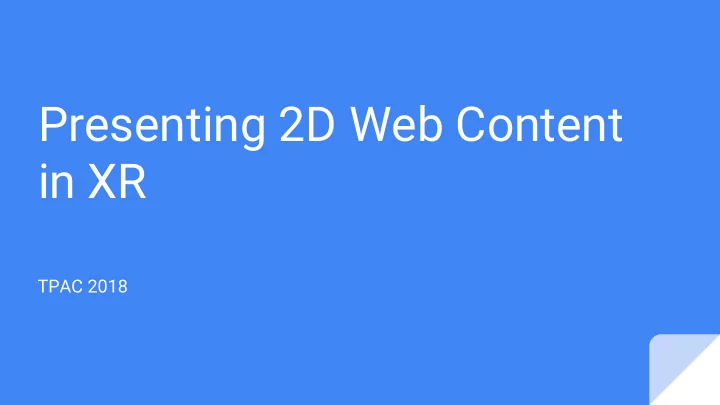

Presenting 2D Web Content in XR TPAC 2018
Overview 2D Web Content in 3D XR - Background Rendering Context - Potential implementation paths forward - Open questions, concerns 2D Web Content in 3D XR Rendering Context
Background - 2D Content in XR 2D Web Content in 3D XR Rendering Context - Overlays for handheld AR. ( DOM to Screen ) - Formatted text, control panels, 2D video players ( DOM to World ) 2D Web Content in 3D XR Rendering Context
Background - Compositors, Quad Layers 2D Web Content in 3D XR New platforms and hardware, new features to explore for rendering 2D Rendering Context content securely and performantly. Compositors - Definition, purpose Predictive rendering - Quad Layer - Definition, purpose - How they work, what that means for rendering behavior e.g. occlusion, depth sensitivity, transparency - How they might help solve existing problems around exposing DOM content to XR context 2D Web Content in 3D XR Rendering Context
User Agents and Compositor Layers: CSS3D 2D Web Content in 3D XR Rendering Context Rendering context and transform-style: preserve-3d; - Elements can request to be in the same 3D context as their parents and sibling elements. - Issues around ordering, depth buffer are effectively avoided by returning 3D objects to a 2D rendering context when certain CSS attributes are defined on elements in the rendering context. Instantiate new rendering context for element with will-change: transform; property - Moves element to its own compositor layer under the hood for transform, animation optimization, etc. - Not in all browsers, limited to max layers underlying platform can support. 2D Web Content in 3D XR Rendering Context
Background - DOM to Texture 2D Web Content in 3D XR History of DOM to Texture Rendering Context - Not a new idea. - First proposed as a way to render 2D web views in WebGL. - No way to implement while safely mitigating security concerns around access to cross-origin content pixel data, input injection. 2D Web Content in 3D XR Rendering Context
Options we investigated 2D Web Content in 3D XR 1. Do nothing Rendering Context 2. Solve for immersive mode on handheld devices only 3. Option 2 + a UA-managed workaround for immersive mode on headset devices 4. Option 2 + quad layers. 5. Revisit feasibility of DOM to texture 2D Web Content in 3D XR Rendering Context
Option 2 - DOM to Screen 2D Web Content in 3D XR Rendering Context - Layout and rendering is required, but should elements be required to be in the DOM tree hierarchy? - Prior art - fullscreen API - Could be implemented as a quad layer? 2D Web Content in 3D XR Rendering Context
Option 4 - DOM to World 2D Web Content in 3D XR DOM quad layer Rendering Context - Input - static or interactive? - Support cross-origin content? - Layout and rendering is required, but should elements be in the DOM tree? - Differences in underlying platform support for quad layers? - Composition order - Occlusion - Input injection - How would we extend WebXR to support multiple layers? 2D Web Content in 3D XR Rendering Context
Inputs 2D Web Content in 3D XR Rendering Context In order to interact with DOM content, UA will need to: - Continue sending pose data as normal through WebXR APIs - Compute raycast intersection for each input source against a quad layer and generating existing DOM events to 2D window coordinates. 2D Web Content in 3D XR Rendering Context
Cross-Origin DOM Content 2D Web Content in 3D XR Visual Representation Rendering Context - No new security concerns with quad layer implementation, parent document does not get access to nested document pixel data Inputs - Security concerns delivering pose data to both document contexts. - Pose data must continue to go to parent document for basic scene rendering - Delivering input injection results in two browsing contexts getting the same input data. 2D Web Content in 3D XR Rendering Context
Differences in underlying platform support - Platform Capabilities Platfor Quad Layer Occlusion Depth Platform Quad Layer Occlusion Depth m Buffer Buffer ARKit N N N OpenVR Y, limited N* N (IVRComposit or::Submit) ARCore N N N OpenXR Y, multiple Y* Y* Google N* N N (XrCompositor VR LayerQuad) SDK WMR N N N Magic N* N N Hololens (MaxQuadLay Leap ers set to 0) Oculus Y, multiple Y Y WMR Y, multiple Only with N* (ovrLayerQ Immersive (HolographicQ other quad uad) Headsets uadLayer) layers
Next Steps 2D Web Content in 3D XR - Rationalize a common abstraction for a quad layer API across different Rendering Context platforms - What changes are necessary for the WebXR API to support multiple layers - If we add support for a new XR layer type, is this the only time it will be necessary to do so or are there other features that will need their own layer abstraction? - Is a quad layer abstraction sufficient for both DOM to screen and DOM to world? - Identifying collaborators for design, action items 2D Web Content in 3D XR Rendering Context
Recommend
More recommend